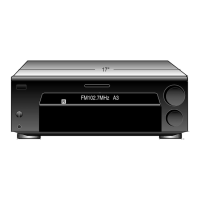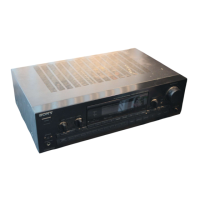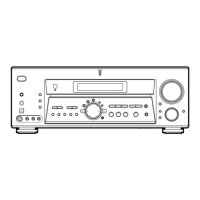Do you have a question about the Sony STR-DB930 and is the answer not in the manual?
Essential safety instructions for preventing fire, shock hazards, and proper power source connection and placement.
Proper methods for cleaning the receiver's exterior surfaces.
Explains manual conventions, icons, and how to use the demonstration mode.
Instructions for unpacking, checking contents, and inserting batteries into the remote.
Guide to connecting FM and AM antennas for optimal reception.
Details on connecting various audio sources like turntables, CD players, and tape decks.
Instructions for connecting video sources like VCRs, DVD players, and TVs.
Guide for connecting digital audio sources and multi-channel audio via 5.1CH inputs.
Covers additional hookups like S-LINK, and connecting the AC power cord with usage cautions.
Instructions for connecting front, rear, and center speakers to the receiver.
Information on speaker impedance and how to avoid short-circuiting.
Steps for clearing memory and performing initial system setup.
Detailed setup for speaker size, distance, position, and subwoofer.
Final checks, connection verification, and troubleshooting before first use.
Overview of front panel parts, including power, function, and volume controls.
How to select input modes for digital sources and change audio/video sources.
Controls for speaker output selection and sound field adjustments.
Details on display dimmer, sound field, bass boost, equalizer, and test tone buttons.
Controls for tuner operations, level/surround/EQ adjustments, and system setup.
Using Auto Format Decoding to present sound as originally encoded.
How to select, turn off, and customize sound fields for optimal listening.
Details on various sound fields like Cinema Studio, Virtual, and Music modes.
Explanation of indicators like OPTICAL, COAXIAL, DIGITAL, PRO LOGIC, DTS, and AC-3.
How source sound formats and output channels are displayed.
Customizing effect level, wall type, reverberation, screen depth, and virtual speakers.
Fine-tuning speaker balance, levels, subwoofer, LFE, and dynamic range.
Modifying bass, midrange, and treble frequencies for front, center, and rear speakers.
Restoring customized sound fields to their original factory settings.
How to tune into radio stations by entering frequency numbers.
How to scan and automatically tune to available radio stations.
Steps for storing and recalling favorite radio stations.
Assigning custom names to preset stations and program sources for easy identification.
Instructions for recording audio onto tape/MD and video onto tape.
How to set the receiver to automatically turn off after a specified time.
Configuration options via SET UP, including CONTROL A1 II and 2 Way Remote.
Steps to resolve issues with no sound or very low-level sound output.
Troubleshooting unbalanced/reversed sound, hum, noise, and intermittent digital sound.
Resolving issues with surround effects, video display, and remote control functionality.
Details on power output, harmonic distortion, and amplifier section performance.
Specifications for various audio/video inputs, outputs, and equalizer settings.
Specs for FM/AM tuners, system details, dimensions, and mass.
Definitions of surround sound elements and types.
Definitions for Dolby Digital (AC-3), Digital Cinema Sound, and Dolby Pro Logic.
Summary table of adjustable parameters for SUR, LEVEL, and EQ buttons.
Summary table of adjustable parameters for SET UP options.
Essential safety instructions for preventing fire, shock hazards, and proper power source connection and placement.
Proper methods for cleaning the receiver's exterior surfaces.
Explains manual conventions, icons, and how to use the demonstration mode.
Instructions for unpacking, checking contents, and inserting batteries into the remote.
Guide to connecting FM and AM antennas for optimal reception.
Details on connecting various audio sources like turntables, CD players, and tape decks.
Instructions for connecting video sources like VCRs, DVD players, and TVs.
Guide for connecting digital audio sources and multi-channel audio via 5.1CH inputs.
Covers additional hookups like S-LINK, and connecting the AC power cord with usage cautions.
Instructions for connecting front, rear, and center speakers to the receiver.
Information on speaker impedance and how to avoid short-circuiting.
Steps for clearing memory and performing initial system setup.
Detailed setup for speaker size, distance, position, and subwoofer.
Final checks, connection verification, and troubleshooting before first use.
Overview of front panel parts, including power, function, and volume controls.
How to select input modes for digital sources and change audio/video sources.
Controls for speaker output selection and sound field adjustments.
Details on display dimmer, sound field, bass boost, equalizer, and test tone buttons.
Controls for tuner operations, level/surround/EQ adjustments, and system setup.
Using Auto Format Decoding to present sound as originally encoded.
How to select, turn off, and customize sound fields for optimal listening.
Details on various sound fields like Cinema Studio, Virtual, and Music modes.
Explanation of indicators like OPTICAL, COAXIAL, DIGITAL, PRO LOGIC, DTS, and AC-3.
How source sound formats and output channels are displayed.
Customizing effect level, wall type, reverberation, screen depth, and virtual speakers.
Fine-tuning speaker balance, levels, subwoofer, LFE, and dynamic range.
Modifying bass, midrange, and treble frequencies for front, center, and rear speakers.
Restoring customized sound fields to their original factory settings.
How to tune into radio stations by entering frequency numbers.
How to scan and automatically tune to available radio stations.
Steps for storing and recalling favorite radio stations.
Assigning custom names to preset stations and program sources for easy identification.
Instructions for recording audio onto tape/MD and video onto tape.
How to set the receiver to automatically turn off after a specified time.
Configuration options via SET UP, including CONTROL A1 II and 2 Way Remote.
Steps to resolve issues with no sound or very low-level sound output.
Troubleshooting unbalanced/reversed sound, hum, noise, and intermittent digital sound.
Resolving issues with surround effects, video display, and remote control functionality.
Details on power output, harmonic distortion, and amplifier section performance.
Specifications for various audio/video inputs, outputs, and equalizer settings.
Specs for FM/AM tuners, system details, dimensions, and mass.
Definitions of surround sound elements and types.
Definitions for Dolby Digital (AC-3), Digital Cinema Sound, and Dolby Pro Logic.
Summary table of adjustable parameters for SUR, LEVEL, and EQ buttons.
Summary table of adjustable parameters for SET UP options.
| Channels | 5.1 |
|---|---|
| Digital Inputs | 2 Optical, 1 Coaxial |
| Tuning Range | FM/AM |
| Input Sensitivity | 150mV (line) |
| Speaker Load Impedance | 8 ohms |
| Tuner Type | Digital |
| Frequency Response | 10Hz to 100kHz |
| Total Harmonic Distortion | 0.05% |
| Video Connections | Composite |
| Surround Sound | Dolby Digital, DTS |
| Video Inputs | Composite |
| Video Outputs | 1 Composite |











